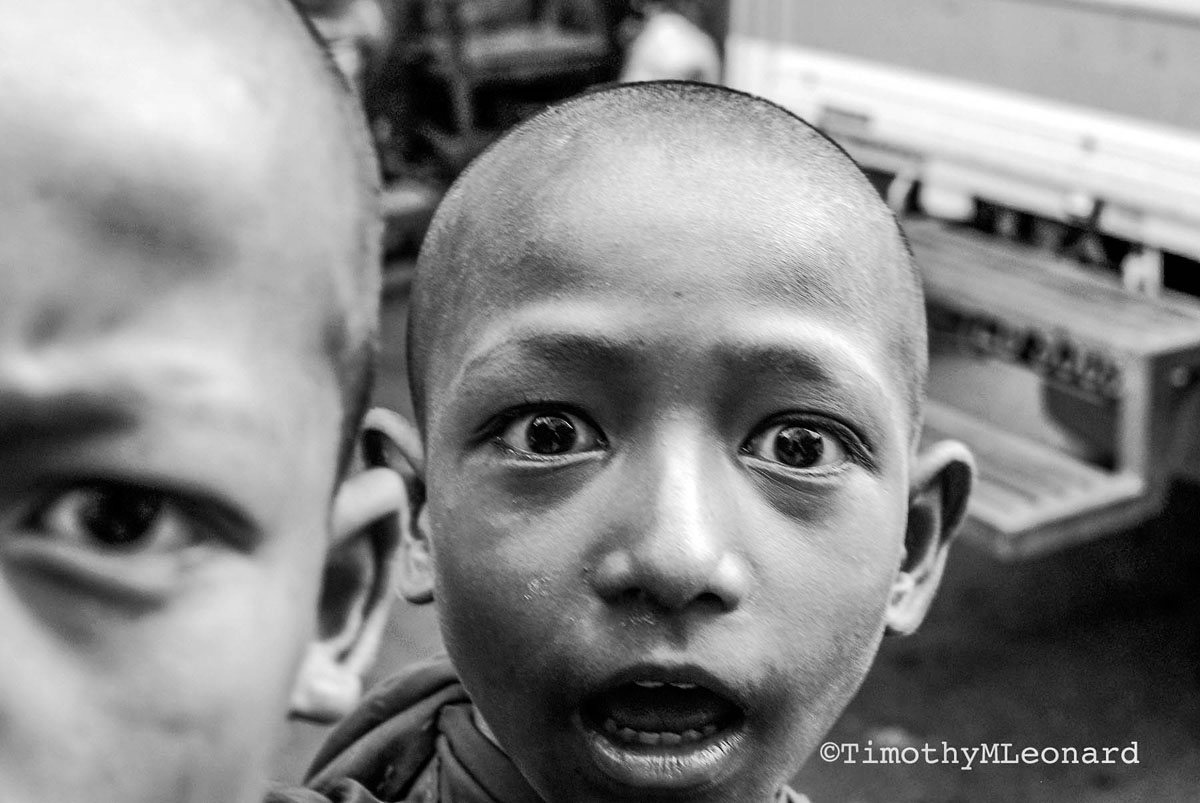Bhutan
 06.2.2014
06.2.2014 One day in the Himalayas I hiked to a meditation hut above Taktsang, Tiger’s Nest, in Druk Yul overlooking the Paro valley laced with rice paddies, rhododendron, fir, spruce, hemlock and barley fields.
Guru Padmasambhava or Guru Rimpoche (Precious Teacher) was the spiritual founder of the Nyingmapa old school of Himalayan Buddhism in 800 A.D. which is still taught in central Bhutan. Tantric Buddhism in Bhutan dates to 450 A.D. and is the esoteric form of the Drukpa Kagyupa Buddhist School. The state religion of Mahayana Buddhism or the Great Vehicle was established in the 8th century.
According to legend, Rimpoche subdued many demons in Paro and central Bhutan. At one time he had two wives, an Indian and a Tibetan. He transformed his Indian wife into a tiger and flew to Taktsang Monastery in the 8th century.
Tiger’s Nest is a series of small tight buildings built into the cliff. It is composed of intricate staircases, stone flagging, a small open air kitchen, balconies, rooms for sleeping, and meditation. I was welcomed by boys and monks who showed me a small meditation room filled with statues, offerings of rice, coins, fruits and vegetables.
They showed me the cave where Rimpoche lived for three years. Three monks appointed by the chief abbot in Thimphu live here for three years for meditation study and are followed by novice monks in their spiritual meditations.
Taktsang, destroyed by a fire in 1998, was rebuilt.
I traveled east along the spine of the dragon climbing to 10,000 feet dropping into valleys and climbing again. Distinct elevations consist of grasslands, crop lands, forests, hardwoods, coniferous forests, soft woods, alpine meadows, yak pastures, and glaciers. Barley, wheat and potatoes are primary spring and summer crops from 7,500-13,000’ with the tree line coming at 12,000-14,000' and coniferous replacing hardwoods above 8,000’.
I passed West Bengal and Indian road gangs working at quarter mile intervals. They perform hard work carrying large rocks and crushing granite to repair and fill the endless washouts. They will live and work here for two or three years maintaining the roads before being replaced by new workers from northern India. Their living situation is very grim. Shelters are woven reeds, fortified with any materials they can find along the rivers. They carry their children on their backs as they work. Younger ones sleep along the road under torn black umbrellas.
Ten thousand people live in the Bumthang area. Small shops and stores along the single main street serve as homes and business. Built of wood with small steel stoves and chimneys, the rooms are multipurpose; selling in front, eating and sleeping quarters in the rear. Merchandise includes thread, wool, fabric for weaving, canned goods, small toys, sweets, local spirits, spices, eggs, a limited supply of green vegetables, a few green apples, and soap.
The architecture is Tibetan, rectangular buildings are two-three stories high, a pitched roof with open space holding firewood and fodder. The middle floor is for storage of grains, seeds and foodstuffs. The upper floor is the living quarters, broken into smaller rooms. The ground floor on a working farm is for the cattle. If not, there are windows at this level with a shop, storeroom, kitchen, and servant’s quarters.
I arrived at a monastery in the foothills overlooking the town where 300-500 Bhutanese gathered to receive a blessing from a lama. Children and adults sit and talk on rows of timber slabs on the sun baked ground.
Three monks blew long wood and silver jallee horns to chase evil spirits away. The lama, Nam Kha Nen Boo, is Khenbow, a reincarnation of a former monk known for his fortune telling power. He was seated and read in a low tone of voice for twenty minutes and used a small hand held drum and bell.
Finished, he moved among the people touching us on the head with a statue called a Tshtshto. This dignifies the life of a human with a blessing “Have a long life.” People approached with offerings for his blessing. Bags of red string, flour, and jenlap, a nutmeg like substance, were offered. One lama handed each person jenlap. Another lama gave each person a single red string to be worn around the neck.
I visited the Jakar Dzong. The head lama opened large doors in the quiet spiritual center. Ornate sculptures of Padmasambhava and flickering yak butter lamps filled the center wall. Inside another room was a ten foot high statue of the guru, bronze statues with salt and butter flower carvings.
Display cases with hundreds of identical 5-6" Buddha statues sat in tiered arrangement extending the length of the room, reaching the ceiling. Larger images depicted historical and religious levels of spiritual attainment.
My meditation is on The Eightfold Path or Middle Way between self-indulgence and self modification. The eight orders are: Right Views, Right Purpose, Right Speech, Right Conduct, Right Livelihood, Right Effort, Right Awareness, and Right Concentration or Right Meditation.
I have a diamond in my mind.
I am alive and empty in the here, now, and present.
Imagination is better than knowledge.
Now I travel south on a path through the jungle.





